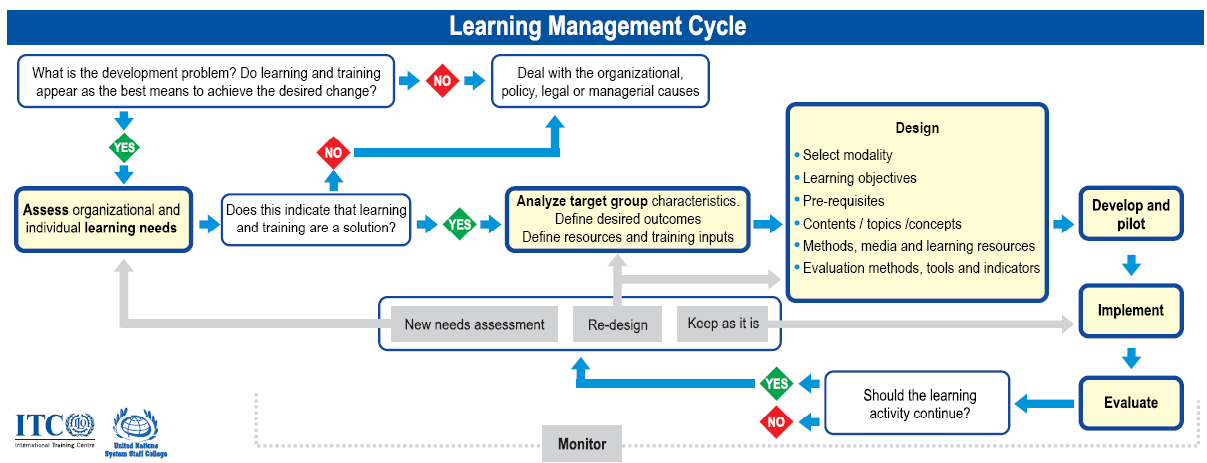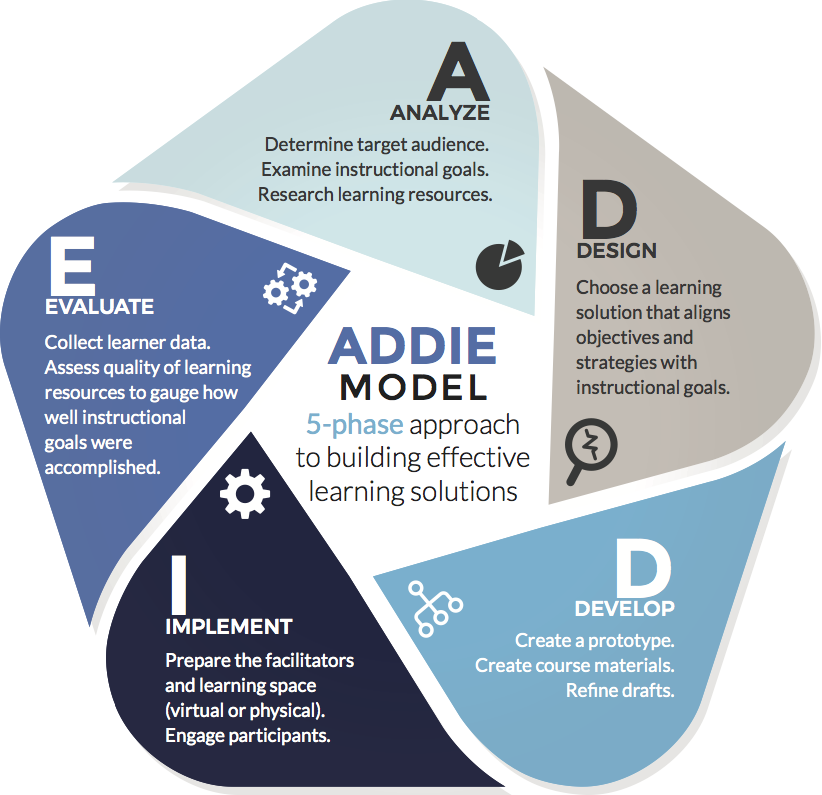Guide on training methodology for EBMOs - Part2
THE LEARNING MANAGEMENT CYCLE

When speaking of providing learning, we must take into account that delivering the training/course is actually an intermediate step to a broader process. It represents neither the start nor the end of our cycle. To easily navigate all the stages and phases of Learning Management, we can use the ADDIE model, an instructional design tool.

ADDIE uses a five-phase approach:
The analysis phase is crucial and should never be undervalued or overlooked. This phase creates the basis for a successful learning activity and will lead to an exhaustive assessment of the learning needs and capacity gaps.
The questions we must address at this stage are:
- What are the expectations of the client?
- What is the capacity gap and what is the desired behaviour from the target group?
- Who are the learners, what are their abilities and their circumstances?
- What is the target group profile?
- What are the learning needs?
- What are constraints and/or resources needed to complete the project?
- What will be the project timeline?
During this stage, take all the information you gathered in your assessment and use it to define the learning objectives, the methodological approach of the training and the training content, and the methods and materials.
The questions we must address at this stage are:
- What specific knowledge do learners need to know?
- What specific competence do learners need to develop?
- What are the learning objectives?
- What do the trainees need to do to achieve these objectives (knowledge, skills, and attitudes)?
- What is the best way for them to learn the knowledge, skills, and attitudes?
- What methodological approach will be used?
- Which tools and indicators will you use to assess that learning is on track?
- Will it be a face-to-face training, and if not, which media platform will you use to deliver the learning activity?
- Who will be delivering the training?
- How will you ensure the trainers are prepared and efficient in delivering the learning activity?
Now that you have a clear outline of the learning activity, you can focus on developing the content, lessons, and materials. You are ready to choose methods and technologies to support the learning and prepare the trainers to deliver an excellent learning activity.
The questions we must address at this stage are:
- What content do you present and how is it presented?
- What methods do you use?
- What materials and handouts do you need?
- What technologies do you use to support the learning?
- What is the educational flow?
- What happens in each session/lesson?
- How do you instruct trainers on the achievement of the expected learning outcomes?
This is the phase when the learning activity takes place and the learning occurs. It is crucial at this stage to monitor the implementation to determine if your design process was a success, where it can be improved, and how better to approach the rest of the model in future.
- Is the strategy working or should it be changed?
Evaluation takes place in many ways throughout the learning management cycle and it is not a separate procedure occurring only in the final stage. Monitoring and evaluation are recurring processes, and it is fundamental to carry them out transversally. Furthermore, environmental and multicultural considerations should also be considered in all phases.
The questions we must address are:
- Can a learning activity respond to the organizational needs? (Analysis)
- Is the design taking in account all the information gathered in the assessment? (Design)
- Is the design responding to learner needs and profile? (Design)
- Are the learning objectives clear, measurable and detailed? (Design)
- Is the methodological approach chosen the most effective available? (Design)
- Is the chosen and presented content relevant? (Develop)
- Are the methods and technologies chosen the most supportive for the target group’s learning? (Develop)
- Are the trainers in the best position to deliver the learning activity?
- Is our design and strategy working? What can be changed or improved? (Implementation)
- Is the trainer implementing the activity accordingly to the design and expectations?
- Did the learners meet the learning objectives? (Final Evaluation)
By consistently carrying out the monitoring and evaluation stages, you will collect vital information from the entire learning cycle. If learners were, for example, unable to meet the objectives, you will be able to use the collected information to determine why that was. You will also be able to compare these notes with the assessment completed during the Analysis phase. This ensures that you can accurately redesign and improve the learning activity.